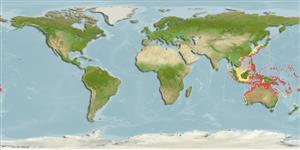Classification / Names
Common names from other countries
Main reference
Size / Weight / Age
Max length : 5.3 cm SL male/unsexed; (Ref. 5978)
Environment
Marine; reef-associated; depth range 18 - 68 m (Ref. 86942)
Climate / Range
Tropical, preferred ?
Distribution
West Pacific: continental margins from Australia and the Philippines; expected elsewhere in Indonesia.
Countries | FAO areas | Ecosystems | Occurrences | Introductions
Short description
Dorsal
spines
(total): 8;
Dorsal
soft rays
(total): 9;
Anal
spines: 2;
Anal
soft rays: 8. This species is characterized by 3 narrow dark stripes, the first from nape along base of first dorsal fin, the second above eye to upper caudal peduncle, the third midlateral from front of snout to end of caudal fin; pectoral rays 13-14; well-developed gill rakers 14-16, total with rudiments 17-21; first dorsal spines 7 (Ref. 58479).
IUCN Red List Status (Ref. 115185)
Threat to humans
Harmless
Human uses
More information
ReferencesAquacultureAquaculture profileStrainsGeneticsAllele frequenciesHeritabilityDiseasesProcessingMass conversion
Tools
Special reports
Download XML
Internet sources
Estimates of some properties based on models
Phylogenetic diversity index
PD50 = 0.5000 many relatives (e.g. carps) 0.5 - 2.0 few relatives (e.g. lungfishes)
Trophic Level
3.4 ±0.45 se; Based on food items.
Resilience
High, minimum population doubling time less than 15 months (Preliminary K or Fecundity.)
Vulnerability
Low vulnerability (10 of 100)
Price category
